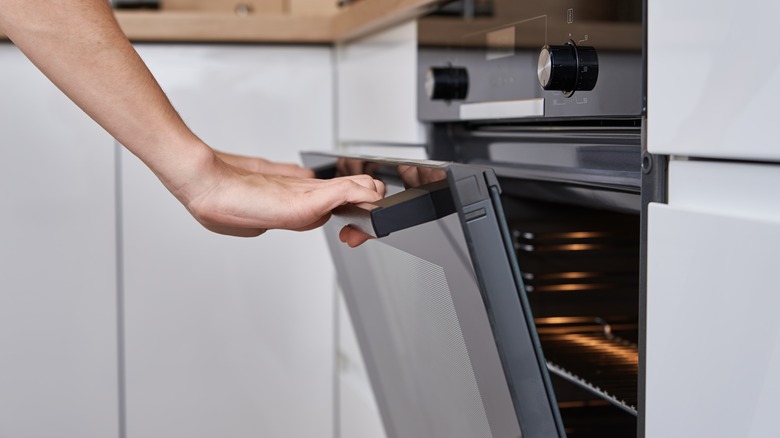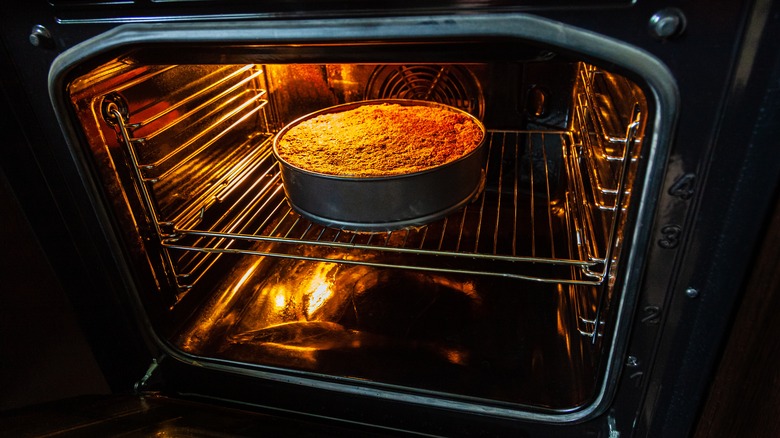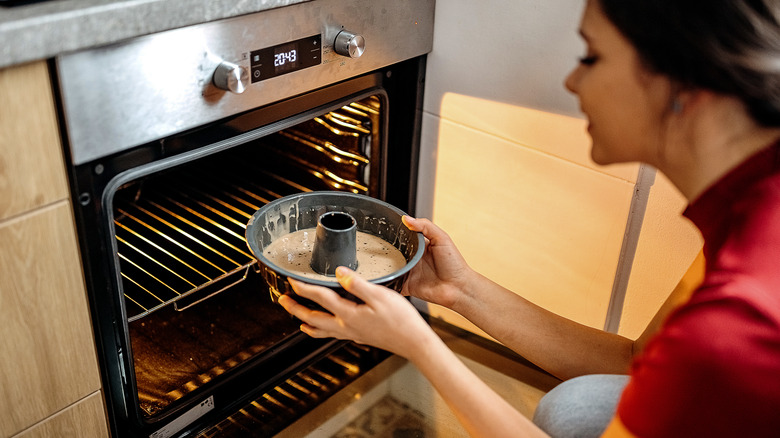Stop Opening Your Oven So Much And Your Cakes Will Stop Sinking
When you're working in the kitchen it's a good habit to always pay close attention to what's going on in the oven. After all, you don't want to overcook or underbake anything after going through all the work of preparing a recipe. There are a lot of times, however, when it pays to be patient, especially when you're baking a cake. It's human nature to want to keep a close eye on a cake while it's baking, especially if you're new to making cakes. However, cakes need even, constant heat in order to rise properly, and every time you open the oven door to take a peek you change the temperature inside. The more you open the oven, the more likely it is that your cake won't rise properly and you'll end up with a flat, dense disk instead of a fluffy, squishy sponge.
When you're baking a cake, think of the scaling and mixing phase as setting the stage for the baking itself. All you need to do as the baker is get all the conditions right and the oven will do the rest. Once the cake is in, set a timer and step away from the stove so that the delicate crumb has the right conditions to develop.
Cake recipes are precise for a reason
Pastry chefs and savory chefs often have very different cooking philosophies. Savory chefs can lean towards more "a little of this and a dash of that," while pastry chefs tend to measure everything in a recipe down to the milligram. This isn't because one kind of chef is more type A than the other, however. Pastry chefs are more exacting because baking recipes are less forgiving; and the balance between dry and wet ingredients, leavening, and heat is an exact science. If there's too much moisture, not enough baking powder, or the batter is overworked, the cake won't come out right and you'll have to start over again.
The same is true for the temperature of the oven; every time you open the door for a look you can lose anywhere from 25 to 150 degrees Fahrenheit. This is important as most cakes rise because they are mixed with leavening agents like baking powder or baking soda, which are activated by heat. Rising is a process where the leavening agents emit gas, which expands and creates air pockets in the cake. If the temperature of the oven drops too often, it will slow down the baking and can even impede the rising process, leaving you with a flat cake.
Always bake your cake with a timer
Baking a cake is exciting, but don't hover around the oven in anticipation. Every cake recipe has a time range in the instructions, and all you need to do is set a timer and step away for a few minutes. When the timer goes off, it's safe to open and check the oven as the bulk of the rising process is over and it's just a matter of checking to see if the crumb is cooked. If you can insert a cake tester or a toothpick and it comes out clean, your cake is ready. If you really want to bake like the pros, try using a quick-read thermometer to test your cake; King Arthur Baking Company says that your cake is done at around 200 to 210 degrees Fahrenheit.
If you really can't resist opening the oven while the cake is baking, Betty Crocker recommends that you wait for at least three-quarters of the cooking time to pass before taking a look. If your cake isn't ready at that point, wait five to 10 more minutes before checking it again to let the oven come back up to temperature and finish the cake.
Once the cake is baked you still have to exercise a little more patience. Let it cool for at least 20 to 30 minutes before attempting to take it out of the pan so it doesn't break, then let it cool for an hour or two before it's finally ready to frost.


